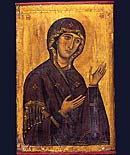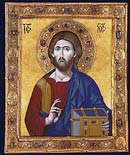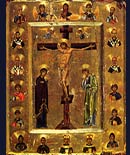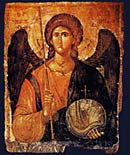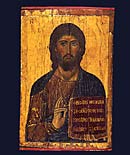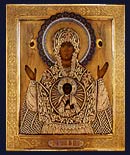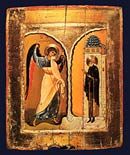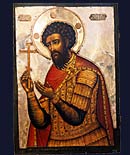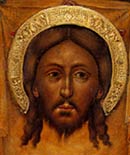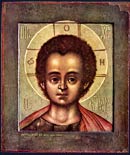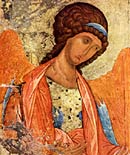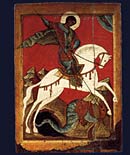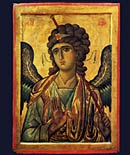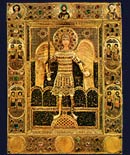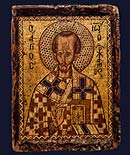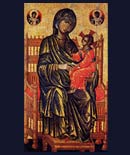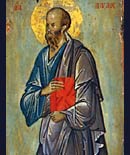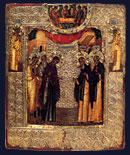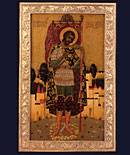Ikon History - Early Russian Ikons
The Russian national state shares common roots with Ukraine in the capital city of ancient Russ, Kiev, situated on the Dnieper River. Old chronicles tell us the pagan rulers of Kiev concluded that their nation was rising on the world stage and as a world power needed to change its religion to increase the spiritual and cultural level of the nation. The chronicles report that the Great Prince of Kiev sent embassies around the world to find the faith that best suited his nation and people. Travelling from nation to nation they visited Muslims and Jews at worship observing their forms of worship and pondering the way of life that each religion taught. The emissaries judged neither of these worthy religions suitable for Russ. Finally, they visited the city of Constantinople and attended Divine Liturgy in the great cathedral of Hagia Sophia. The Russians were dumfounded by the richness and sublime beauty of the service, the church and the celestial singing of the Byzantine choirs in the lofty, domed cathedral. They breathlessly reported back to Kiev that in Hagia Sophia they were unable to tell if they were on earth or in heaven. The choice was made, Byzantine Orthodoxy it would be.
In 988 the Great Prince of Kiev, Vladimir, accepted baptism for himself and ordered his whole nation to follow his example. In doing this he acknowledged the fact that Christianity had already made tremendous inroads into the life of ancient Russ. For more than 100 years evangelists from the Byzantine world had achieved great success in converting his people to Orthodox Christianity. In fact, Kievian Russ instinctively looked down the Dnieper past the Black Sea to the great city of Constantinople for her cultural and spiritual inspiration. Russian merchants, churchman and warriors, travelled to Constantinople regularly and saw first hand how things where done in the Imperial city they called $#34;Tsargrad". Church services back home in Kiev were closely modeled upon Byzantine norms and many ikons and liturgical furnishings where brought back for Kiev's growing number of sanctuaries.
Although the first ikons in Kiev were certainly imported, Byzantine artists were soon lured north to Kiev to work and teach their craft there. The most important and influential school of painting in Russia was established in the famous catacomb Monastery of the Caves. The earliest ikons painted in Russia closely followed Byzantine models. It took some time for the Russian masters to acquire the high technical level of Constantinople. The enormous ikon at upper left, is composed of three boards fused together and is called the Great Panagia. This ikon was known in Russia as the paladin or protector of princes and most probably decorated a column in one of the Great Prince's churches. The Theotokos is painted in a severe, classical style, with her arms extended in prayer. In her breast is an aureole containing the image of Christ in her womb. Above both of her arms are images of two archangels holding glass orbs topped with crosses adoring the Theotokos and Christ. The Virgin stands upon a red carpet which is a good example of Christian carpet weaving of the time. Her robes are imperial purple and dark blue, liberally splashed with wide areas of gold. What is interesting about the ikon is the confidence of the painter in deviating from a simple slavish copying of inherited Byzantine forms.
The painter has modeled the face of the Virgin in an almost abstract fashion with vibrant color and subtle shading. The majestic, unearthly effect of this ikon is a precursor to later Russian ikon painting which reaches its zenith in the transandental works of Andrei Rublev four hundred years later.
An alternate form of this ikon, showing the Theotokos only to the waist, is called "Znaminie" in Russia, or "Our Lady of the Sign". The example at lower right was painted 700 years after the Great Panagia The ikon continued to be associated with Russian princes and the Court Church of Tsarskoe Selo outside St. Petersburg was dedicated to it. The last Tsarina of Russia, Alexandra Fyodorovna, had a special copy made of this ikon which she always carried with her. It was called "Our Lady of Tsarskoe Selo" and other copies where placed in most of the private rooms of the Tsar's palace.
Below this ikon is the famous Christ, "Painted Without Hands", which was displayed in the Moscow Kremlin Cathedral of the Assumption, where Russian Tsars were crowned, until the Bolshevik Revolution, when it was removed to a museum. The ikon is based on the famous Veil or mandylion of King Abgarus. The first record of this ikon dates from 590, when a Byzantine historian recorded the story of the ikon, which was miraculously imprinted upon a cloth by Christ himself. King Abgarus of Edessa had asked Christ for a picture of Himself and this was sent in reply. The cloth remained in Edessa until 944 when it was transferred to Constantinople to wild celebrations. The Byzantine Emperor received the Holy Veil himself and had it transferred to the Palatine Chapel. The Mandylion is sometimes confused with the Holy Shroud or "Sindona" in Turin.
The ikon of the Holy Veil pictured here has the same monumental style as the Great Panagia and is certainly produced in the same era. The face is quite similar to other ikons of this period, such as the great Christ of Cefalu in Palermo, Sicily. It is possible they are all based on a celebrated image of Christ created in Constantinople which is now lost to us. The drawing of this ikon is extremely sure and the strong lines of the face are complimented by thin gold lines which highlight the hair. The piercing glaze of this ikon was much noted and it was frequently copied.
The next ikon on the left is the famous Angel "With the Golden Hair". Its tender gaze is quite a contrast to the stern face of Christ in the Holy Veil. The painting of the face is quite remarkable, showing the smooth graduations of fused color which were typical of Comnenian art in Constantinople during the 12th century. The last ikon is the famous Virgin of Vladimir, which came to Russia from Constantinople in 1131. The soft modeling of the faces and the intensity of the tender feeling of this ikon had a major impact on Russian art of the time. The ikon went through many troubles and repaintings before it arrived in Moscow, where it was placed on the ikonostasis of the Assumption Cathedral in the Kremlin. "Vladimirskaya", as the ikon is called in Russia, was the holiest religious image in the country. As such, it attracted the interest of the Soviet Government in 1918 and was removed from the cathedral for restoration before it was placed in a glass case at the History Museum in Moscow and then was transferred the Tretyakov Museum in 1930. Of the original painting only the faces and small patch on Christ's shoulder remain.
Next chapter: Medieval balkan States
